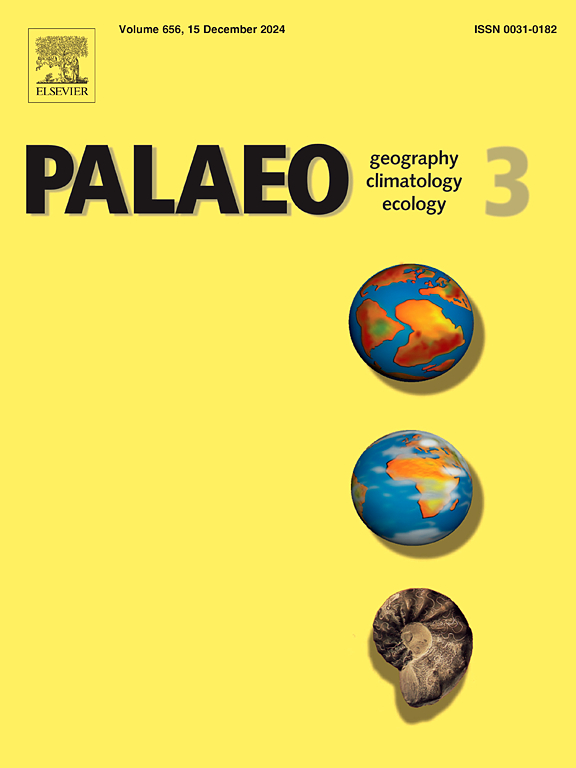Hydroclimate changes in Northern Taiwan during 13.3 cal kyr BP through the Tsui Tsui Valley sediments
IF 2.6
2区 地球科学
Q2 GEOGRAPHY, PHYSICAL
Palaeogeography, Palaeoclimatology, Palaeoecology
Pub Date : 2025-02-01
DOI:10.1016/j.palaeo.2025.112775
引用次数: 0
Abstract
To fill the gap of climate information of the northern Taiwan region before the late Holocene, an attempt has been made through the analysis of two sediment cores from Tsui Tsui Valley (TTV-11 and TTV-17), which together cover the time period from 13.3 cal kyr BP to the present. To achieve this, multiple proxies, including diatoms, micro-XRF, carbon isotopic composition, and elemental carbon (C) and nitrogen (N) concentrations, were analyzed. The diatom data indicated that water levels were high from 11.1 to 8.8 cal kyr BP, suggesting the lacustrine conditions, which likely outburst due to increased runoff conditions during 8.8 cal kyr BP. The Principal Component (PC) Analysis of the micro-XRF records from both cores showed a strong positive correlation between detrital proxy elements (Ti, Fe, K, and Si) and PC2 (PC2TTV-11 and PC2TTV-17), indicating higher/lower runoff and wet/dry climate conditions. Overall, in the current study, TTV-11 core records showed a transition from wet to dry conditions during 13.3 to 11.0 cal kyr BP along with drier climate events during 12.9–12.6, 12.4–12.1, and 12.0–11.7 cal kyr BP, which coincided with the timing and duration of Younger Dryas event. After 11.7 cal kyr BP, the climate was transformed to wetter conditions towards 8.0 cal kyr BP, with intermittent drier climate events at 11.0, 10.3, and 8.2 cal kyr BP. In addition, the TTV-17 records showed wet climate conditions during 4.5–3.0, 2.0–1.7, 1.2–0.8, and 0.4–0.2 cal kyr BP. In contrast, dry climate conditions were noticed during 3.0–2.0, 1.7–1.2, and 0.8–0.4 cal kyr BP. The Mn/Fe ratios, inc/coh ratios, C and N contents, and PC2 suggested that organic matter dilution by inorganic (detrital) material during wetter climate conditions. The drier climate conditions occurred between 13.3 and 8.0 cal kyr BP were largely coincided with strong East Asian Winter Monsoon (EAWM) and weak East Asian Summer Monsoon (EASM), which driven by Arctic ice sea expansion and low winter insolation, and dry climate conditions which occurred between 4.5 cal kyr BP to present, were response of negative Atlantic Meridional Overturning Circulation (AMOC) and El Niño-Southern Oscillation. On the other hand, wet climate conditions observed in the current study were the response to strong EASM, a response to La-Niña conditions in the Pacific Ocean, and weak EAWM due to positive AMOC.
求助全文
约1分钟内获得全文
求助全文
来源期刊
CiteScore
5.90
自引率
10.00%
发文量
398
审稿时长
3.8 months
期刊介绍:
Palaeogeography, Palaeoclimatology, Palaeoecology is an international medium for the publication of high quality and multidisciplinary, original studies and comprehensive reviews in the field of palaeo-environmental geology. The journal aims at bringing together data with global implications from research in the many different disciplines involved in palaeo-environmental investigations.
By cutting across the boundaries of established sciences, it provides an interdisciplinary forum where issues of general interest can be discussed.

 求助内容:
求助内容: 应助结果提醒方式:
应助结果提醒方式:


